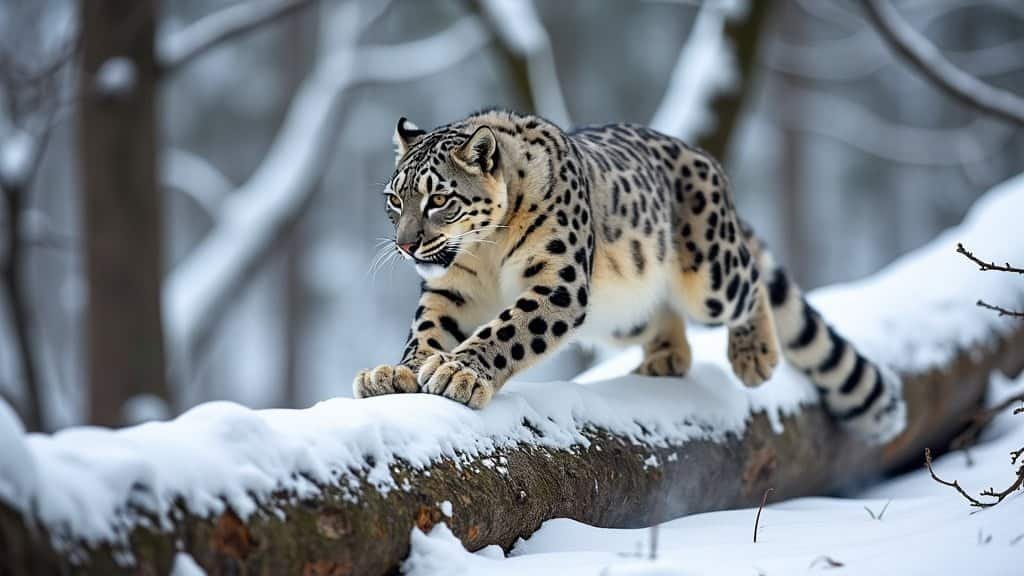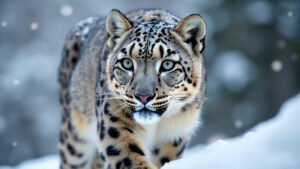Introduction
The Global Snow Leopard & Ecosystem Protection Program (GSLEP) plays a crucial role in safeguarding one of the world’s most elusive and endangered big cats—the snow leopard
This international initiative unites twelve snow leopard range countries with the shared goal of protecting and preserving these majestic animals and their habitats
Throughout this article, we will explore GSLEP’s main objectives, its contributions to conservation efforts, the countries involved, specific actions taken, methods of monitoring and tracking populations, challenges faced, and future plans for ensuring the survival of snow leopards
Main Objectives of GSLEP
The Global Snow Leopard & Ecosystem Protection Program (GSLEP) aims to secure the long-term survival of snow leopards and their mountain ecosystems
Launched in 2013, GSLEP focuses on collaborative, cross-border conservation efforts among the 12 snow leopard range countries: Afghanistan, Bhutan, China, India, Kazakhstan, Kyrgyzstan, Mongolia, Nepal, Pakistan, Russia, Tajikistan, and Uzbekistan
The program’s comprehensive approach encompasses habitat preservation, community engagement, and scientific research to address the multifaceted challenges facing snow leopards and their habitats
Key Goals
The primary goal of GSLEP is to ensure that snow leopards and the people who share their habitat coexist peacefully. To achieve this, GSLEP has outlined several key objectives:
Protecting Habitat: Safeguarding and managing the ecosystems that snow leopards inhabit is crucial. This involves protecting critical landscapes, establishing conservation areas, and promoting sustainable land-use practices
Engaging Local Communities: Local communities play a vital role in conservation. GSLEP works to involve them in conservation efforts, offering education and sustainable livelihood options that reduce human-wildlife conflict
Enhancing Knowledge and Capacity: Building scientific and technical capacity among stakeholders is essential. GSLEP supports research, monitoring, and training programs to enhance understanding of snow leopard ecology and conservation strategies
Strengthening Policies and Cooperation: Effective conservation requires strong policies and international cooperation. GSLEP advocates for policy improvements and fosters cross-border collaborations to address threats like poaching and habitat fragmentation
Conservation Targets
GSLEP has set specific conservation targets to guide its efforts:
20 Ecosystem Management Units (EMUs): GSLEP aims to secure 20 priority landscapes across the snow leopard range by 2020, each managed sustainably to support viable snow leopard populations
Population Monitoring: The program focuses on enhancing population monitoring through the development and implementation of standardized protocols. This ensures accurate data collection and analysis for informed decision-making
Human-Wildlife Conflict Mitigation: Reducing conflict between snow leopards and local communities is a priority. GSLEP promotes the use of predator-proof livestock corrals and community-based livestock insurance schemes to minimize losses and foster coexistence
Ecosystem Protection
Protecting snow leopards also means preserving the broader ecosystems they inhabit. These mountainous regions are vital for biodiversity, water resources, and climate regulation. GSLEP’s ecosystem protection strategies include:
Integrated Landscape Management: This approach considers the entire ecosystem, promoting biodiversity conservation alongside sustainable development. It involves stakeholders at all levels to ensure that conservation measures benefit both wildlife and local communities
Climate Change Adaptation: Mountain ecosystems are particularly vulnerable to climate change. GSLEP works to enhance the resilience of these habitats through adaptive management practices, research on climate impacts, and the implementation of mitigation strategies
Transboundary Conservation: Many snow leopard habitats span national borders. GSLEP promotes transboundary cooperation to ensure cohesive conservation efforts across entire landscapes, addressing threats that do not adhere to political boundaries
Contributions to Snow Leopard Conservation
The Global Snow Leopard & Ecosystem Protection Program (GSLEP) has made significant strides in snow leopard conservation through various initiatives and strategies
These efforts are essential for ensuring the survival of snow leopards and the health of their ecosystems. Below, we delve into the primary contributions GSLEP has made in this regard
Habitat Preservation
Habitat preservation is at the core of GSLEP’s mission. Snow leopards require vast territories to thrive, and preserving these habitats is crucial for their survival:
Protected Areas: GSLEP has been instrumental in establishing and expanding protected areas within the snow leopard range. This includes national parks, wildlife reserves, and conservation zones. These protected areas provide safe havens for snow leopards and other wildlife
Corridor Connectivity: Ensuring connectivity between fragmented habitats is essential for maintaining genetic diversity and enabling snow leopards to move freely across their range. GSLEP supports the creation of wildlife corridors that link isolated populations, allowing for greater mobility and reducing the risk of inbreeding
Sustainable Land Use: GSLEP promotes sustainable land-use practices that benefit both snow leopards and local communities. This includes working with governments and stakeholders to implement policies that balance conservation with development, such as sustainable grazing practices and eco-friendly tourism
Anti-Poaching Efforts
Poaching poses a significant threat to snow leopards, driven by demand for their pelts and body parts in illegal wildlife trade. GSLEP has implemented several measures to combat poaching:
Strengthening Law Enforcement: GSLEP collaborates with law enforcement agencies to enhance their capacity to combat wildlife crime. This includes training rangers, improving surveillance, and providing equipment for anti-poaching patrols
Community Rangers: Engaging local communities in anti-poaching efforts is crucial. GSLEP supports the recruitment and training of community rangers who monitor snow leopard populations and report illegal activities. This approach not only aids conservation but also provides employment opportunities for locals
Awareness Campaigns: Raising awareness about the importance of snow leopard conservation and the legal consequences of poaching is essential. GSLEP conducts educational campaigns targeting local communities, tourists, and policymakers to foster a culture of conservation and respect for wildlife laws
Research and Data Collection
Scientific research and data collection are fundamental to effective conservation. GSLEP places a strong emphasis on gathering accurate data to inform its strategies:
Population Surveys: Regular population surveys using advanced techniques like camera trapping and genetic analysis help estimate snow leopard numbers and assess population trends. This data is crucial for setting conservation priorities and measuring progress
Ecological Studies: Understanding the ecology of snow leopards, including their behavior, diet, and habitat use, is vital for effective management. GSLEP supports ecological studies that provide insights into these aspects, helping to tailor conservation efforts to the specific needs of snow leopards
Threat Assessments: Identifying and assessing threats to snow leopards, such as habitat loss, climate change, and human-wildlife conflict, allows GSLEP to develop targeted interventions. These assessments are based on rigorous scientific research and community input
Collaboration and Partnerships
GSLEP’s success is built on collaboration and partnerships with various stakeholders, including governments, NGOs, local communities, and international organizations:
Government Collaboration: GSLEP works closely with the governments of snow leopard range countries to develop and implement national conservation strategies. This collaboration ensures that conservation efforts are supported by strong policies and adequate resources
NGO Partnerships: Partnerships with non-governmental organizations bring additional expertise, funding, and on-the-ground support to GSLEP’s initiatives. These collaborations enhance the program’s capacity to address complex conservation challenges
International Cooperation: GSLEP fosters international cooperation through platforms like the Global Snow Leopard Forum. This forum brings together representatives from range countries, conservation organizations, and experts to share knowledge, discuss challenges, and coordinate efforts
Countries Involved in GSLEP
The Global Snow Leopard & Ecosystem Protection Program (GSLEP) represents a collaborative effort among 12 snow leopard range countries, each playing a crucial role in conserving these endangered big cats and their habitats
This international coalition is fundamental to GSLEP’s success, ensuring comprehensive and unified action across the snow leopard’s range
Participating Nations
GSLEP unites the following countries, all of which have significant snow leopard populations within their borders:
Afghanistan: Home to several snow leopard habitats, Afghanistan focuses on strengthening community-based conservation and anti-poaching efforts
Bhutan: With its rich biodiversity, Bhutan prioritizes habitat preservation and sustainable land-use practices to protect its snow leopard population
China: Holding the largest snow leopard range, China plays a vital role in research, habitat connectivity, and combating illegal wildlife trade
India: India emphasizes community engagement, habitat conservation, and robust anti-poaching measures across its mountainous regions
Kazakhstan: Efforts in Kazakhstan include habitat preservation, scientific research, and fostering regional cooperation for conservation
Kyrgyzstan: Known for its snow leopard population, Kyrgyzstan leads initiatives in population monitoring, community involvement, and transboundary conservation
Mongolia: Mongolia focuses on extensive research, habitat protection, and community-based conservation programs
Nepal: Nepal’s approach includes integrating conservation with local livelihoods, rigorous scientific studies, and strong anti-poaching strategies
Pakistan: Pakistan’s initiatives emphasize community stewardship, habitat restoration, and addressing human-wildlife conflict
Russia: In Russia, conservation efforts include protecting large tracts of habitat, scientific research, and international cooperation
Tajikistan: Tajikistan works on habitat connectivity, engaging local communities, and enhancing anti-poaching efforts
Uzbekistan: Uzbekistan’s focus is on habitat conservation, population monitoring, and regional collaboration
Collaborative Projects
Each of the participating nations contributes to various collaborative projects under GSLEP, which include:
Transboundary Conservation Initiatives: Countries like China, Mongolia, and Russia engage in projects that facilitate snow leopard movement across borders, ensuring genetic diversity and population stability
Community-Based Conservation Programs: Nations such as Nepal and Pakistan implement projects that integrate local communities into conservation efforts, providing them with sustainable livelihood options and involving them in anti-poaching activities
Research and Monitoring: Countries like India and Kyrgyzstan focus on extensive scientific research and monitoring to gather data on snow leopard populations, behavior, and habitat use. These projects often involve international research institutions and NGOs
Capacity Building and Training: Efforts in countries like Bhutan and Afghanistan include training local conservationists, rangers, and community members in wildlife monitoring, anti-poaching tactics, and sustainable practices
Regional Initiatives
Within GSLEP, regional initiatives are tailored to address specific challenges and leverage the strengths of participating countries:
Central Asian Initiatives: Countries such as Kazakhstan, Kyrgyzstan, and Tajikistan work together on regional projects that focus on habitat connectivity, addressing poaching, and promoting sustainable land-use practices in the Central Asian highlands
Himalayan Initiatives: India, Nepal, and Bhutan collaborate on conservation efforts in the Himalayan region, focusing on habitat preservation, research, and community engagement to protect snow leopards and their ecosystems
Altai-Sayan Initiatives: Russia and Mongolia lead projects in the Altai-Sayan region, emphasizing transboundary conservation, scientific research, and habitat protection
Global Forums and Partnerships
GSLEP’s efforts are reinforced through global forums and partnerships that bring together representatives from the participating countries, international organizations, and conservation experts:
Global Snow Leopard Forum: This forum serves as a platform for range countries to share knowledge, discuss conservation strategies, and coordinate efforts. It facilitates high-level dialogue and collaboration among government officials, scientists, and conservationists
International Partnerships: GSLEP partners with international NGOs, research institutions, and funding organizations to enhance its capacity and resources. These partnerships support various projects, from research and monitoring to community-based conservation and policy development
Funding and Resource Allocation: Participating countries, along with international partners, contribute to the funding and resources needed for GSLEP projects. This collective investment ensures the implementation of effective conservation strategies across the snow leopard range
Specific Actions Taken by GSLEP
The Global Snow Leopard & Ecosystem Protection Program (GSLEP) employs a range of specific actions to achieve its conservation goals. These actions encompass community engagement, policy development, and resource allocation, all aimed at creating a sustainable environment for snow leopards and the ecosystems they inhabit
Community Engagement
Engaging local communities is a cornerstone of GSLEP’s strategy. By involving those who live alongside snow leopards, GSLEP fosters a sense of stewardship and ensures that conservation efforts are both effective and sustainable:
Educational Programs: GSLEP conducts educational programs to raise awareness about snow leopard conservation. These programs target various demographics, including school children, local leaders, and community members, highlighting the importance of preserving snow leopards and their habitats
Livelihood Initiatives: To reduce human-wildlife conflict, GSLEP supports livelihood initiatives that offer sustainable alternatives to traditional practices that may harm snow leopards. These initiatives include promoting eco-tourism, handicrafts, and sustainable agriculture
Community-Based Monitoring: GSLEP involves local communities in monitoring snow leopard populations and their prey. Community members are trained to use camera traps and other monitoring tools, providing valuable data while fostering a sense of ownership and responsibility
Policy Development
Effective policy development is crucial for long-term conservation success. GSLEP works with governments to create and implement policies that protect snow leopards and their habitats:
National Action Plans: GSLEP assists range countries in developing and implementing National Snow Leopard and Ecosystem Protection Action Plans. These plans outline specific conservation strategies, targets, and actions tailored to each country’s unique challenges and opportunities
Legal Frameworks: Strengthening legal frameworks is essential for combating poaching and illegal trade. GSLEP advocates for the enactment and enforcement of stringent wildlife protection laws and regulations
International Agreements: GSLEP promotes and supports international agreements and treaties that enhance transboundary conservation efforts. These agreements facilitate cooperation between countries, ensuring cohesive strategies for snow leopard protection across borders
Resource Allocation
Allocating resources effectively ensures that conservation efforts are well-supported and impactful. GSLEP focuses on mobilizing financial, technical, and human resources to support its initiatives:
Funding Programs: GSLEP collaborates with international donors, governments, and NGOs to secure funding for conservation projects. This funding supports a wide range of activities, from research and monitoring to community engagement and anti-poaching efforts
Technical Assistance: Providing technical assistance is vital for building local capacity. GSLEP offers training and support in areas such as wildlife monitoring, habitat management, and community engagement to enhance the skills and knowledge of local conservationists and stakeholders
Equipment and Infrastructure: GSLEP ensures that the necessary equipment and infrastructure are in place to support conservation activities. This includes providing camera traps, GPS collars, and other monitoring tools, as well as establishing field stations and research centers
Collaborative Projects
Collaboration is key to the success of GSLEP’s specific actions. The program works with various stakeholders, including governments, NGOs, research institutions, and local communities, to implement comprehensive conservation projects:
SMART Patrolling: GSLEP uses the Spatial Monitoring and Reporting Tool (SMART) to enhance patrolling efforts. This tool helps rangers and community members collect, store, and analyze data on wildlife and illegal activities, improving the efficiency and effectiveness of anti-poaching efforts
Snow Leopard Enterprises: This initiative empowers local communities by providing them with alternative income sources. Participants create and sell handicrafts, generating income while reducing dependency on livestock, which in turn reduces human-wildlife conflict
Climate Resilience Projects: GSLEP implements projects that enhance the resilience of snow leopard habitats to climate change. These projects focus on habitat restoration, sustainable land management, and research on climate impacts, ensuring that snow leopard ecosystems remain viable in the face of changing environmental conditions
Field Research and Monitoring
Field research and monitoring are fundamental to understanding snow leopard populations and their habitats. GSLEP supports a range of research and monitoring activities to gather essential data and inform conservation strategies:
Camera Trapping: Camera traps are widely used to monitor snow leopard populations and their prey. These non-invasive tools provide valuable insights into snow leopard behavior, population density, and habitat use
Genetic Analysis: Collecting and analyzing genetic samples from snow leopards helps scientists understand population structure, genetic diversity, and connectivity between populations. This information is crucial for developing effective conservation strategies
Radio Collar Tracking: Radio collars fitted on snow leopards allow researchers to track their movements and behavior. This data helps identify critical habitats, movement corridors, and potential threats, informing targeted conservation actions
Monitoring and Tracking Snow Leopard Populations
Monitoring and tracking snow leopard populations are critical components of conservation efforts. By understanding the distribution, population size, and behavior of snow leopards, conservationists can implement more effective strategies to protect these elusive big cats
The Global Snow Leopard & Ecosystem Protection Program (GSLEP) employs various methods and technologies to monitor and track snow leopards
Technology Used
Advanced technologies play a vital role in monitoring snow leopards. These tools provide precise and reliable data, helping conservationists make informed decisions:
Camera Traps: Camera traps are a primary tool for monitoring snow leopards. These motion-activated cameras are strategically placed in snow leopard habitats to capture images and videos of these elusive animals. Camera traps provide valuable information on snow leopard presence, population density, and behavior
GPS Collars: GPS collars fitted on snow leopards allow researchers to track their movements in real-time. These collars provide data on the animals’ home ranges, migration patterns, and habitat use. GPS collars are essential for understanding snow leopard ecology and identifying critical habitats and corridors
Drones: Unmanned aerial vehicles (drones) are increasingly used in wildlife monitoring. Drones can cover large areas quickly and access remote or difficult terrains, providing high-resolution images and videos of snow leopard habitats. This technology helps in mapping landscapes, identifying potential threats, and monitoring habitat changes
Field Studies
Field studies are essential for collecting baseline data and understanding the ecological needs of snow leopards. GSLEP supports various field research activities that contribute to snow leopard conservation:
Population Surveys: Regular population surveys are conducted to estimate snow leopard numbers and assess population trends. These surveys use a combination of methods, including camera traps, genetic analysis, and direct sightings. Population surveys are crucial for monitoring the effectiveness of conservation efforts and making data-driven decisions
Prey Base Studies: Snow leopards rely on a healthy prey base for survival. Field studies focus on understanding the abundance and distribution of prey species such as blue sheep, ibex, and Himalayan tahr. These studies help conservationists manage habitats to ensure sufficient prey availability for snow leopards
Habitat Assessment: Assessing the quality and extent of snow leopard habitats is vital for conservation planning. Field studies evaluate habitat characteristics, such as vegetation, water sources, and terrain, to identify key areas for protection and restoration
Data Analysis
Data analysis is a critical step in transforming raw data into actionable insights. GSLEP employs various analytical methods to interpret the data collected from field studies and monitoring tools:
Spatial Analysis: Spatial analysis involves mapping and analyzing the geographic distribution of snow leopards and their habitats. This analysis helps identify important habitats, movement corridors, and areas of human-wildlife conflict. Spatial data is used to prioritize conservation actions and design effective management plans
Population Modeling: Population models simulate the dynamics of snow leopard populations under different scenarios. These models consider factors such as birth rates, mortality rates, and habitat quality to predict population trends and assess the impact of conservation interventions. Population models guide decision-making and help set realistic conservation targets
Genetic Analysis: Genetic analysis provides insights into the genetic diversity and connectivity of snow leopard populations. By analyzing DNA samples collected from scat, hair, or tissue, researchers can determine genetic relationships, identify distinct populations, and assess gene flow between populations. This information is crucial for maintaining genetic health and designing conservation corridors
Collaboration with Local Communities
Involving local communities in monitoring and tracking efforts is essential for the success of snow leopard conservation. GSLEP promotes community-based monitoring programs that empower local people and enhance conservation outcomes:
Training Programs: GSLEP provides training to local communities on wildlife monitoring techniques, data collection, and the use of monitoring tools. These training programs build local capacity and ensure that community members can effectively contribute to snow leopard conservation
Citizen Science: Community members participate in citizen science initiatives, collecting data on snow leopard sightings, tracks, and signs. This grassroots involvement increases the reach and effectiveness of monitoring efforts while fostering a sense of stewardship among local people
Human-Wildlife Conflict Mitigation: Monitoring data is used to address human-wildlife conflicts, such as livestock predation by snow leopards. GSLEP works with local communities to implement measures like predator-proof corrals and livestock insurance schemes, reducing conflicts and promoting coexistence
Challenges in Monitoring and Tracking
Monitoring and tracking snow leopards present several challenges due to the species’ elusive nature and the harsh environments they inhabit. GSLEP addresses these challenges through innovative solutions and adaptive management:
Remote and Rugged Terrain: Snow leopards inhabit remote and mountainous regions, making access and data collection difficult. GSLEP uses advanced technologies like drones and satellite imagery to overcome these challenges and improve data accuracy
Climate Conditions: Harsh weather conditions in snow leopard habitats can hinder monitoring efforts. GSLEP employs robust and weather-resistant equipment to ensure continuous data collection even in extreme conditions
Funding and Resources: Limited funding and resources can constrain monitoring activities. GSLEP seeks support from international donors, governments, and NGOs to secure the necessary resources for comprehensive monitoring and tracking programs
Future Plans for Snow Leopard Conservation
The Global Snow Leopard & Ecosystem Protection Program (GSLEP) is continuously evolving to address emerging challenges and leverage new opportunities for the conservation of snow leopards
The future plans of GSLEP are focused on expanding and enhancing current efforts, integrating innovative approaches, and fostering stronger international collaborations to ensure the survival of snow leopards and the health of their ecosystems
Upcoming Projects
GSLEP has several upcoming projects aimed at addressing critical areas of snow leopard conservation:
Expanding Protected Areas: One of GSLEP’s primary goals is to increase the coverage and connectivity of protected areas within the snow leopard range. Future projects will focus on designating new protected areas, expanding existing ones, and establishing corridors that link fragmented habitats. This expansion is crucial for maintaining viable snow leopard populations and ensuring genetic diversity
Climate Change Adaptation: As climate change poses a growing threat to snow leopard habitats, GSLEP is prioritizing projects that enhance the resilience of these ecosystems. This includes researching the impacts of climate change on snow leopards and their prey, implementing habitat restoration projects, and developing adaptive management strategies to mitigate climate-related risks
Community-Based Conservation: Building on the success of current community engagement efforts, GSLEP plans to launch new initiatives that further integrate local communities into conservation activities. These projects will focus on sustainable livelihoods, conflict mitigation, and education programs that promote coexistence between humans and snow leopards
Long-Term Strategies
GSLEP’s long-term strategies aim to create sustainable frameworks for snow leopard conservation that can adapt to changing circumstances and emerging threats:
Enhanced Research and Monitoring: To improve the understanding of snow leopard ecology and population dynamics, GSLEP will invest in cutting-edge research and monitoring technologies. This includes expanding the use of camera traps, GPS collars, and drones, as well as developing new methodologies for population surveys and genetic analysis. Continuous research will provide the data needed to adapt and refine conservation strategies
Strengthening Policy and Governance: Effective conservation requires strong policies and governance structures. GSLEP will work with governments to strengthen wildlife protection laws, improve enforcement mechanisms, and promote policies that support sustainable land use. Additionally, GSLEP will advocate for the inclusion of snow leopard conservation in national and regional development plans
Fostering International Collaboration: Recognizing that snow leopard conservation is a global responsibility, GSLEP will enhance international cooperation through partnerships with governments, NGOs, research institutions, and international organizations. This collaboration will facilitate the sharing of knowledge, resources, and best practices, ensuring a cohesive and coordinated approach to conservation
Global Partnerships
GSLEP’s future plans emphasize the importance of global partnerships in achieving conservation goals:
Collaborative Research Networks: GSLEP will establish and support collaborative research networks that bring together scientists, researchers, and conservationists from around the world. These networks will facilitate the exchange of information and expertise, leading to more effective and innovative conservation solutions
Funding and Resource Mobilization: Securing sustainable funding is essential for the success of conservation efforts. GSLEP will engage with international donors, foundations, and the private sector to mobilize the necessary financial resources. This includes exploring new funding mechanisms such as conservation finance and eco-tourism revenue sharing
Capacity Building: Building the capacity of local conservationists and stakeholders is crucial for long-term success. GSLEP will provide training and support to enhance the skills and knowledge of those involved in snow leopard conservation. This includes workshops, field training programs, and exchange visits to promote learning and collaboration
Innovative Approaches
GSLEP is committed to integrating innovative approaches into its conservation strategies:
Technology Integration: Embracing new technologies can revolutionize conservation efforts. GSLEP will explore the use of artificial intelligence, machine learning, and big data analytics to enhance monitoring, data analysis, and decision-making processes. These technologies can provide deeper insights into snow leopard behavior, threats, and habitat use
Conservation Genetics: Genetic research can provide critical information for managing snow leopard populations. GSLEP plans to invest in conservation genetics projects that assess genetic diversity, identify distinct populations, and guide the establishment of genetic corridors. This will help maintain healthy and resilient snow leopard populations
Ecosystem-Based Management: GSLEP will promote an ecosystem-based management approach that considers the entire landscape and its ecological processes. This holistic perspective ensures that conservation efforts benefit not only snow leopards but also other species and the broader ecosystem services that support human well-being
Educational Outreach
Education and awareness are key components of GSLEP’s future plans:
Public Awareness Campaigns: Increasing public awareness about snow leopard conservation is vital for garnering support and promoting sustainable behaviors. GSLEP will launch targeted awareness campaigns using various media platforms, including social media, documentaries, and community events
School Programs: Engaging young people in conservation is essential for long-term success. GSLEP will develop and implement school programs that educate students about snow leopards, their ecosystems, and the importance of conservation. These programs will include interactive activities, field trips, and conservation clubs
Conservation Ambassadors: GSLEP will identify and train conservation ambassadors from local communities, who can champion snow leopard conservation and inspire others to get involved. These ambassadors will play a crucial role in spreading awareness and mobilizing community action
Conclusion
The Global Snow Leopard & Ecosystem Protection Program (GSLEP) plays a pivotal role in safeguarding snow leopards and their mountain habitats
Through its multifaceted approach, GSLEP addresses the key challenges facing snow leopard conservation by focusing on habitat preservation, community engagement, anti-poaching efforts, and scientific research
The program unites twelve range countries in a collaborative effort, enhancing the effectiveness of conservation actions through international cooperation and shared resources
GSLEP’s comprehensive strategy includes establishing and expanding protected areas, promoting sustainable land-use practices, and fostering community-based conservation initiatives. The program’s use of advanced technologies like camera traps, GPS collars, and drones has significantly improved the monitoring and tracking of snow leopard populations, providing essential data for informed decision-making
Looking forward, GSLEP is committed to expanding its efforts with upcoming projects that focus on climate change adaptation, further community engagement, and increased international collaboration
Long-term strategies involve enhanced research, stronger policy frameworks, and innovative conservation techniques, ensuring that snow leopard conservation adapts to emerging challenges
Through global partnerships and a commitment to integrating new technologies and approaches, GSLEP aims to create a sustainable future where snow leopards and local communities coexist harmoniously. By continuing to build on its successes and addressing new challenges with innovative solutions, GSLEP strives to secure the survival of snow leopards and the health of their ecosystems for generations to come











